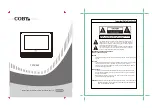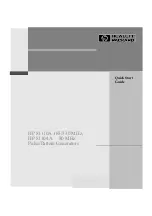
4
REV A
OPM-136
3. NOISE HAZARD -
Excessive noise is not only tiring, but continual exposure can lead to
loss of hearing.
A. Use hearing protection when working around this
equipment for long periods of time.
B. Keep your neighbors in mind when permanently installing this
equipment.
4. CLEANLINESS -
Keep the generator and surrounding area clean.
A. Remove all grease, ice, snow or materials that create slippery
conditions around the unit.
B. Remove any rags or other materials that could create a
potential fire hazard.
C. Carefully clean up any gas or oil spills before starting the unit.
5. SERVICING EQUIPMENT -
All service, including the installation or replacement of service parts,
should be performed only by a qualified technician.
A. Use only factory approved repair parts.
B. Do not work on this equipment fatigued.
C. Use extreme caution when working on electrical components.
High output voltages from this equipment can cause serious
injury or death.
D. Installing a generator is not a “do-it-yourself” project. Consult
a qualified, licensed electrician or contractor. The installation
must comply with all national, state, and local codes.
6.
INSTALLATION -
Installing a PTO generator is not a “do-it-yourself” project. Consult
a qualified, licensed electrician or contractor. The installation must
comply with all national, state, and local codes.
A. Never operate the PTO drive generator without having it
properly mounted to a concrete base or approved trailer.
b. Never connect the PTO generator to an existing electrical
system without installing an isolation transfer switch.
C. Always insure the drive shaft is straight and level before
operating
the
generator.
8. OPERATION - PTO drive shafts (tumbling bars) have many inherent
dangers, extreme caution must be exercised when using them.
A. NEVER allow children around the drive shaft when it is in
operation.
B. Keep all safety guards and shields in place and securely
tightened.
C. Never operate a drive shaft that has been damaged or had the
safety shield removed.
D. Never step over a drive shaft while it is running.
E. Never wear a necktie, loose articles of clothing, or anything else
that can be caught in moving parts.
F. Never try to stop drive shaft with your hand or your foot.
SAFETY
IMPORTANT SAFETY INSTRUCTIONS
SAVE THESE INSTRUCTIONS
This manual contains important information that should be understood
and followed before the installation, operation and maintenance of the
generator. Failure to follow the safety instructions in this manual could
result in serious injury or death. Keep this manual available for future
reference.
CALIFORNIA PROPOSITION 65
WARNING:
This product contains crude oil, gasoline,
diesel fuel and other petroleum products, Antifreeze to
which can expose you to chemicals including toluene
and benzene, Ethylene glycol (ingested) which are
known to the State of California to cause cancer, birth defects or other
reproductive harm and developmental issues.
For more information go to www.P65Warning.ca.gov.
ANSI SAFETY DEFINITIONS
DANGER:
DANGER indicates an imminently hazardous situation which, if not
avoided,
will
result in death or serious injury. This signal word is to be
limited to the most extreme situations.
WARNING:
WARNING indicates a potentially hazardous situation which, if not
avoided,
could
result in death or serious injury.
CAUTION:
CAUTION indicates a potentially hazardous situation which, if not
avoided,
may
result in minor or moderate injury. It may be used to alert
against unsafe practices.
NOTE: CAUTION is also used on the unit labels and in this manual to
indicate a situation that could result in serious damage or destruction of
the equipment and possible personal injury.
1. ELECTRIC SHOCK -
The output voltage present in this equipment can cause a fatal electric
shock. This equipment must be operated by a responsible person.
A. Do not allow anyone to operate the generator without proper
instruction.
B. Guard against electric shock.
C. Avoid contact with live terminals or receptacles.
D. Use extreme care if operating this unit in rain or snow.
E. Use only three-prong grounded plugs and extension cords.
F. Be sure the unit is properly grounded to an external ground rod
driven into the earth.
2. FIRE HAZARD -
A. Keep a fire extinguisher nearby and know its proper use. Fire
extinguishers rated ABC by NFPA are appropriate.


































